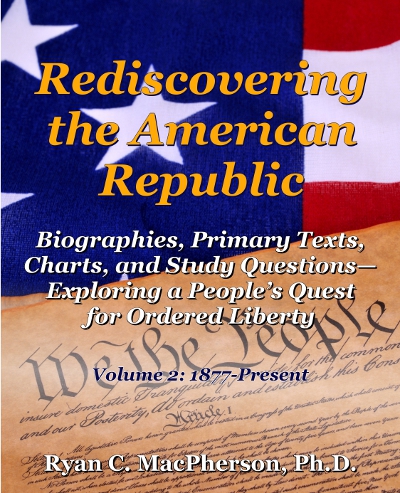Excerpted from: Rediscovering the American Republic, vol. 1: 1492–1877
Leading Americans have often turned to religion as the tool for properly balancing liberty with order. As John Adams remarked, “Our constitution is only fit for a moral and religious people. It is wholly unsuited to the governance of any other kind.” But to acknowledge that Adams was correct does not settle the matter so simply. One still must consider at least two other questions. First, which religion fosters the optimal relation between liberty and order? Second, what is the best means for instilling such religion in the hearts of the American people? America’s founders debated answers to both of these questions. The Puritans sought to establish the ideal state-church in Massachusetts Bay Colony (see p. 60). William Penn, a Quaker, took a different approach in Pennsylvania: religious toleration of diverse sects, albeit mostly still within the purview of Christianity (see p. 103). James Madison and Thomas Jefferson opposed the appropriation of state funds to sponsor any particular church, but Congress was not shy to affirm in the Northwest Land Ordinance of 1787 that “religion, morality, and knowledge, being necessary to good government and the happiness of mankind, schools and the means of education shall forever be encouraged.” As the French political historian Alexis de Tocqueville noted in his Democracy in America (2 vols., 1835–1840), the American people are deeply religious, a fact to which he attributed the remarkable stability that American democracy had achieved; in other words, Tocqueville concluded that American religion is essential to maintaining an ordered liberty (see p. 460).
Americans’ views on race have also profoundly shaped the historical development of the United States. People of African and European descent have interacted with one another, and with Native Americans, from colonial times to the present day. From the nineteenth century onward, Latinos and Asians have become increasingly involved in forging the American nation. The U.S. census today classifies Americans into five races, but many Americans are multiracial and each supposed race is also quite diverse within itself. For example, Irish Americans initially were not included as “whites,” but now they are; nor are Norwegian Americans and Italian Americans “white” in quite the same sense. Both for good (celebrating one’s ethnic heritage) and for evil (practicing racial bigotry), Americans often have defined themselves in terms of race. Although racial categories sometimes have seemed “convenient” for elites desiring to establish a social order—most notably through the antebellum enslavement of blacks by whites—such arrangements make hypocrites of those professing a commitment to liberty (see especially pp. 531–32). Even amid the horrors of slavery, the American creed remained as an inner voice of self-criticism, calling upon white Americans to right their wrongs against blacks and to build a new kind of society in which liberty and order could mutually support one another. This was the triumph of Abraham Lincoln’s vision, realized fleetingly during the Civil War and Reconstruction (see pp. 679, 681–82) and resumed in more recent memory during the Civil Rights Movement.
The region presently occupied by the United States previously was inhabited by numerous Native American tribes. During the sixteenth through eighteenth centuries, several European nations—principally Spain, France, Holland, and England—claimed sections of this land (see pp. 43–46). Through a series of wars and treaties, much of it became part of the United States, which emerged from thirteen former British colonies. During the nineteenth century, the United States spread westward, most notably by purchasing Louisiana from France (see pp. 360–62) and by claiming as spoils of war the northern third of what had been Mexico (see p. 484). Regional variations in American culture have profoundly impacted our shared history, as can be demonstrated most dramatically in the Civil War that erupted between the North and the South in the 1860s. In the twentieth and twenty-first centuries, America’s region of influence has spread around the globe, giving region even broader significance in shaping American identity. It may even be suggested that through its foreign policy, the United States has come to regard ordered liberty as its most valuable export. Such a posture, of course, begs the question of whether America has the right approach—for this nation or for any nation.
Americans long have viewed rights, the fourth R of American history, in a broadly universal sense. The Declaration of Independence states that “all men are . . . endowed by their Creator with certain unalienable rights,” thus recognizing God to be the source, and all of humanity to be the recipient, of fundamental rights to “life, liberty, and the pursuit of happiness.” Americans value rights to free speech, trial by jury, and private property. African Americans’ quest for equal rights has been central to the American experience from the emergence of race-based slavery in the colonial era to the present-day debates concerning affirmative action. In fact, rights also relates back to another R, region, since a fundamental question of American politics concerns whether the local, state, or federal government should have the final word. Moreover, the very notion of natural rights ties politics inextricably to the first R, religion, because the philosophy of natural law predicates both liberty and order on the divine design for human nature. Americans are so dedicated to the notion of rights that their most divisive controversies tend to involve competing frameworks of rights. For example, the abortion debate of today hinges upon the scope and priority of a child’s right to life in relation to his or her mother’s right to liberty, even as the slavery debates of yesteryear involved a contest between slaveholders claiming a property right over human chattel versus enslaved persons asserting their rights to life and liberty (see especially pp. 531–32).
- To learn more, purchase:
- See also:


